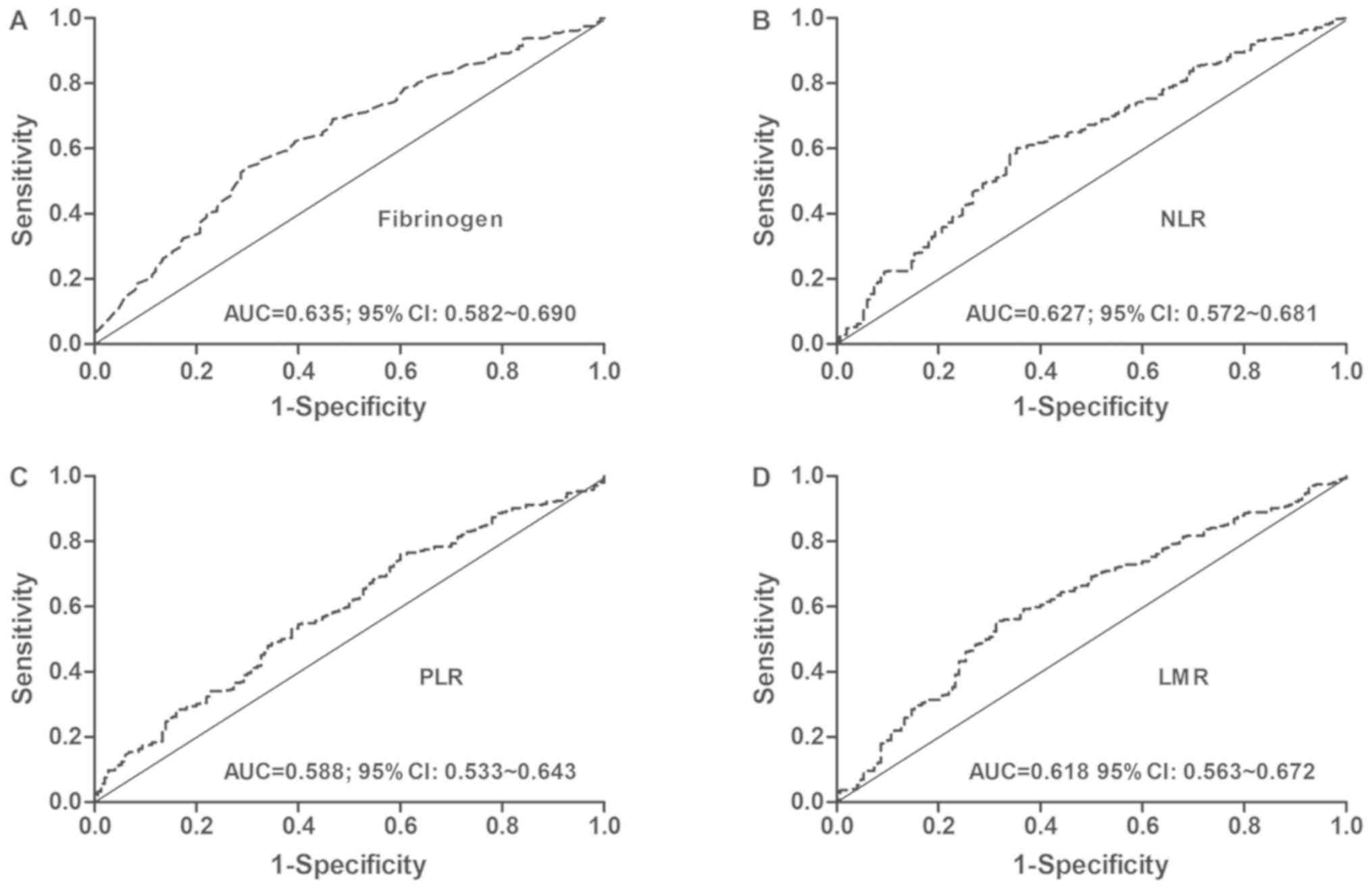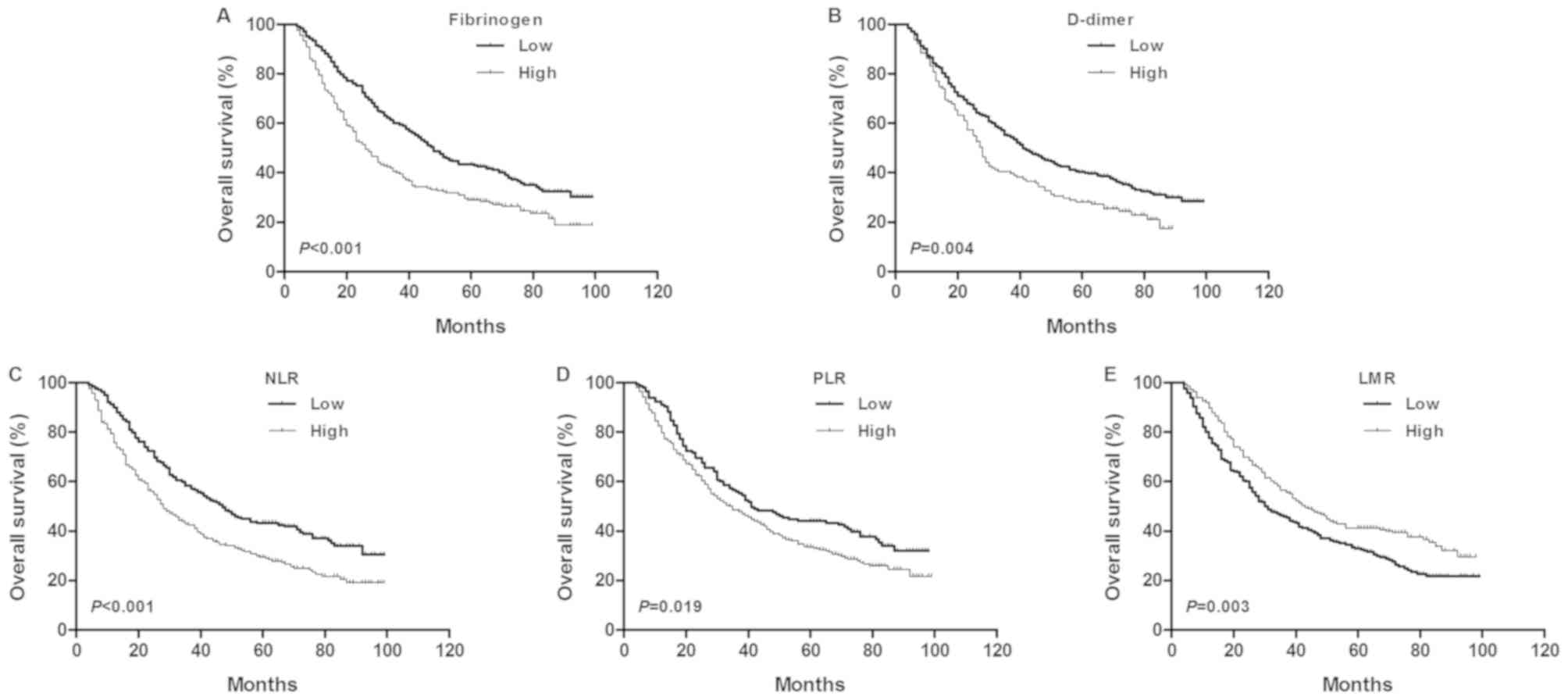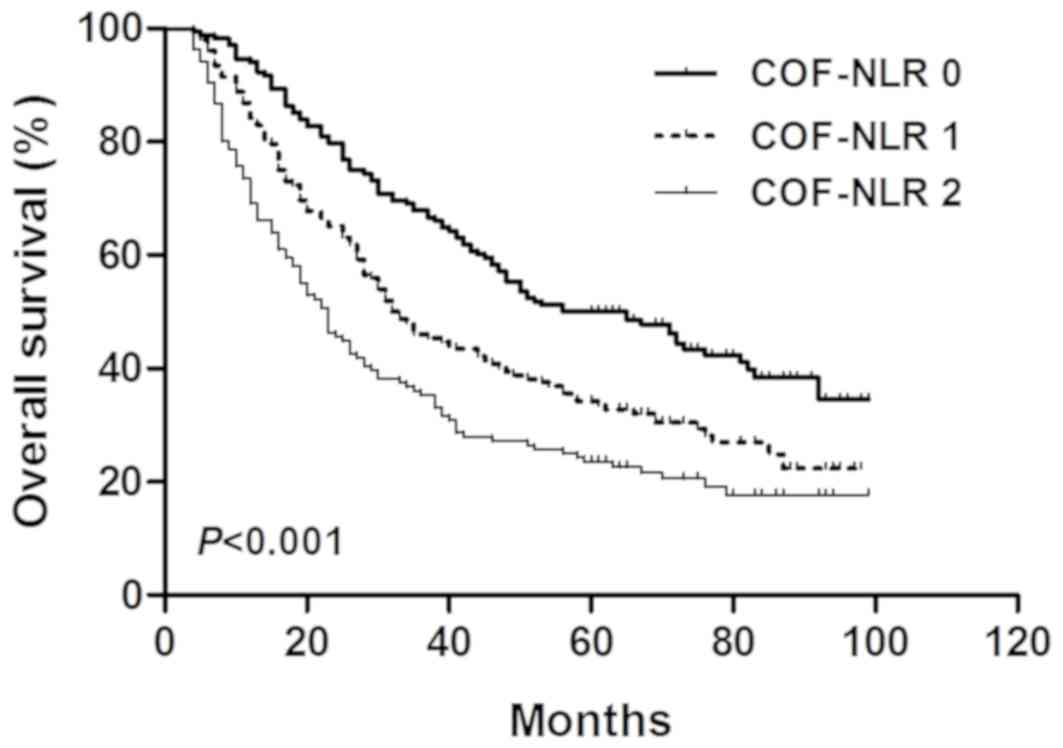|
1
|
Siegel RL, Miller KD and Jemal A: Cancer
statistics, 2015. CA Cancer J Clin. 65:5–29. 2015. View Article : Google Scholar : PubMed/NCBI
|
|
2
|
Kamangar F, Dores GM and Anderson WF:
Patterns of cancer incidence, mortality, and prevalence across five
continents: Defining priorities to reduce cancer disparities in
different geographic regions of the world. J Clin Oncol.
24:2137–2150. 2006. View Article : Google Scholar : PubMed/NCBI
|
|
3
|
Zeng Q, Xue N, Dai D, Xing S, He X, Li S,
Du Y, Huang C, Li L and Liu W: A nomogram based on inflammatory
factors C-reactive protein and fibrinogen to predict the prognostic
value in patients with resected non-small cell lung cancer. J
Cancer. 8:744–753. 2017. View Article : Google Scholar : PubMed/NCBI
|
|
4
|
Murray JC: Coagulation and cancer. Br J
Cancer. 64:422–424. 1991. View Article : Google Scholar : PubMed/NCBI
|
|
5
|
Son HJ, Park JW, Chang HJ, Kim DY, Kim BC,
Kim SY, Park SC, Choi HS and Oh JH: Preoperative plasma
hyperfibrinogenemia is predictive of poor prognosis in patients
with nonmetastatic colon cancer. Ann Surg Oncol. 20:2908–2913.
2013. View Article : Google Scholar : PubMed/NCBI
|
|
6
|
Vahid DM, Ahmari S, Alipour S and
Tehranian A: The comparison of plasma D-dimer levels in benign and
malignant tumors of cervix, ovary and uterus. Int J Hematol Oncol
Stem Cell Res. 9:107–111. 2015.PubMed/NCBI
|
|
7
|
Nakamura K, Nakayama K, Ishikawa M,
Katagiri H, Minamoto T, Ishibashi T, Ishikawa N, Sato E, Sanuki K,
Yamashita H, et al: High pre-treatment plasma D-Dimer level as a
potential prognostic biomarker for cervical carcinoma. Anticancer
Res. 36:2933–2938. 2016.PubMed/NCBI
|
|
8
|
Dirix LY, Salgado R, Weytjens R, Colpaert
C, Benoy I, Huget P, van Dam P, Prové A, Lemmens J and Vermeulen P:
Plasma fibrin D-dimer levels correlate with tumour volume,
progression rate and survival in patients with metastatic breast
cancer. Br J Cancer. 86:389–395. 2002. View Article : Google Scholar : PubMed/NCBI
|
|
9
|
Dunn GP, Old LJ and Schreiber RD: The
immunobiology of cancer immunosurveillance and immunoediting.
Immunity. 21:137–148. 2004. View Article : Google Scholar : PubMed/NCBI
|
|
10
|
McMillan DC: Systemic inflammation,
nutritional status and survival in patients with cancer. Curr Opin
Clin Nutr Metab Care. 12:223–226. 2009. View Article : Google Scholar : PubMed/NCBI
|
|
11
|
Arigami T, Uenosono Y, Matsushita D,
Yanagita S, Uchikado Y, Kita Y, Mori S, Kijima Y, Okumura H,
Maemura K, et al: Combined fibrinogen concentration and
neutrophil-lymphocyte ratio as a prognostic marker of gastric
cancer. Oncol Lett. 11:1537–1544. 2016. View Article : Google Scholar : PubMed/NCBI
|
|
12
|
Arigami T, Okumura H, Matsumoto M,
Uchikado Y, Uenosono Y, Kita Y, Owaki T, Mori S, Kurahara H, Kijima
Y, et al: Analysis of the fibrinogen and neutrophil-lymphocyte
ratio in esophageal squamous cell carcinoma: A promising blood
marker of tumor progression and prognosis. Medicine (Baltimore).
94:e17022015. View Article : Google Scholar : PubMed/NCBI
|
|
13
|
Fu SJ, Ji F, Han M, Chen MG, Wang XP, Ju
WQ, Zhao Q, Wu LW, Ren QQ, Guo ZY, et al: Prognostic value of
combined preoperative fibrinogen and neutrophil-lymphocyte ratio in
patients with hepatocellular carcinoma after liver transplantation.
Oncotarget. 8:4301–4312. 2017.PubMed/NCBI
|
|
14
|
Xia H, Sun Z, Deng L, Zhu D and Wang D:
Prognostic significance of the preoperative lymphocyte to monocyte
ratio in patients with stage I non-small cell lung cancer
undergoing complete resection. Cancer Invest. 34:378–384. 2016.
View Article : Google Scholar : PubMed/NCBI
|
|
15
|
Dorn-Beineke A, Dempfle CE, Bertsch T and
Wisser H: Evaluation of the automated coagulation analyzer Sysmex
CA-7000. Thromb Res. 116:171–179. 2005. View Article : Google Scholar : PubMed/NCBI
|
|
16
|
Tian S: Classification and survival
prediction for early-stage lung adenocarcinoma and squamous cell
carcinoma patients. Oncol Lett. 14:5464–5470. 2017.PubMed/NCBI
|
|
17
|
Fang L, Sheng H, Wan D, Zhu C, Jiang R,
Sun X and Feng J: Prognostic role of multidrug
resistance-associated protein 1 expression and platelet count in
operable non-small cell lung cancer. Oncol Lett. 16:1123–1132.
2018.PubMed/NCBI
|
|
18
|
Zou Q, Wang T, Li B, Li G, Zhang L, Wang B
and Sun S: Overexpression of circ-0067934 is associated with
increased cellular proliferation and the prognosis of non-small
cell lung cancer. Oncol Lett. 16:5551–5556. 2018.PubMed/NCBI
|
|
19
|
Yamashita H, Kitayama J, Kanno N, Yatomi Y
and Nagawa H: Hyperfibrinogenemia is associated with lymphatic as
well as hematogenous metastasis and worse clinical outcome in T2
gastric cancer. BMC Cancer. 6:1472006. View Article : Google Scholar : PubMed/NCBI
|
|
20
|
Palumbo JS: Mechanisms linking tumor
cell-associated procoagulant function to tumor dissemination. Semin
Thromb Hemost. 34:154–160. 2008. View Article : Google Scholar : PubMed/NCBI
|
|
21
|
Lal I, Dittus K and Holmes CE: Platelets,
coagulation and fibrinolysis in breast cancer progression. Breast
Cancer Res. 15:2072013. View
Article : Google Scholar : PubMed/NCBI
|
|
22
|
Weisel JW: Fibrinogen and fibrin. Adv
Protein Chem. 70:247–299. 2005. View Article : Google Scholar : PubMed/NCBI
|
|
23
|
Arpaia G, Carpenedo M, Verga M,
Mastrogiacomo O, Fagnani D, Lanfredini M, Milani M and Cimminiello
C: D-dimer before chemotherapy might predict venous
thromboembolism. Blood Coagul Fibrinolysis. 20:170–175. 2009.
View Article : Google Scholar : PubMed/NCBI
|
|
24
|
Yamaguchi T, Yamamoto Y, Yokota S,
Nakagawa M, Ito M and Ogura T: Involvement of interleukin-6 in the
elevation of plasma fibrinogen levels in lung cancer patients. Jpn
J Clin Oncol. 28:740–744. 1998. View Article : Google Scholar : PubMed/NCBI
|
|
25
|
Garcia MG, Bayo J, Bolontrade MF, Sganga
L, Malvicini M, Alaniz L, Aquino JB, Fiore E, Rizzo MM, Rodriguez
A, et al: Hepatocellular carcinoma cells and their fibrotic
microenvironment modulate bone marrow-derived mesenchymal stromal
cell migration in vitro and in vivo. Mol Pharm. 8:1538–1548. 2011.
View Article : Google Scholar : PubMed/NCBI
|
|
26
|
Zheng S, Shen J, Jiao Y, Liu Y, Zhang C,
Wei M, Hao S and Zeng X: Platelets and fibrinogen facilitate each
other in protecting tumor cells from natural killer cytotoxicity.
Cancer Sci. 100:859–865. 2009. View Article : Google Scholar : PubMed/NCBI
|
|
27
|
Vesely MD and Schreiber RD: Cancer
immunoediting: Antigens, mechanisms, and implications to cancer
immunotherapy. Ann N Y Acad Sci. 1284:1–5. 2013. View Article : Google Scholar : PubMed/NCBI
|
|
28
|
Wu G, Yao Y, Bai C, Zeng J, Shi D, Gu X,
Shi X and Song Y: Combination of platelet to lymphocyte ratio and
neutrophil to lymphocyte ratio is a useful prognostic factor in
advanced non-small cell lung cancer patients. Thorac Cancer.
6:275–287. 2015. View Article : Google Scholar : PubMed/NCBI
|
|
29
|
Lee S, Oh SY, Kim SH, Lee JH, Kim MC, Kim
KH and Kim HJ: Prognostic significance of neutrophil lymphocyte
ratio and platelet lymphocyte ratio in advanced gastric cancer
patients treated with FOLFOX chemotherapy. BMC Cancer. 13:3502013.
View Article : Google Scholar : PubMed/NCBI
|
|
30
|
Hirahara N, Matsubara T, Mizota Y,
Ishibashi S and Tajima Y: Prognostic value of preoperative
inflammatory response biomarkers in patients with esophageal cancer
who undergo a curative thoracoscopic esophagectomy. BMC Surg.
16:662016. View Article : Google Scholar : PubMed/NCBI
|
|
31
|
Neagoe PE, Brkovic A, Hajjar F and Sirois
MG: Expression and release of angiopoietin-1 from human
neutrophils: Intracellular mechanisms. Growth Factors. 27:335–344.
2009. View Article : Google Scholar : PubMed/NCBI
|
|
32
|
Hoffmann TK, Dworacki G, Tsukihiro T,
Meidenbauer N, Gooding W, Johnson JT and Whiteside TL: Spontaneous
apoptosis of circulating T lymphocytes in patients with head and
neck cancer and its clinical importance. Clin Cancer Res.
8:2553–2562. 2002.PubMed/NCBI
|
|
33
|
Gabazza E, Taguchi O, Yamakami T, Machishi
M, Ibata H and Suzuki S: Correlation between increased granulocyte
elastase release and activation of blood coagulation in patients
with lung cancer. Cancer. 72:2134–2140. 1993. View Article : Google Scholar : PubMed/NCBI
|
|
34
|
Ma C, Lu B, Diao C, Zhao K, Wang X, Ma B,
Lu B and Sun E: Preoperative neutrophil-lymphocyte ratio and
fibrinogen level in patients distinguish between muscle-invasive
bladder cancer and non-muscle-invasive bladder cancer. Onco Targets
Ther. 9:4917–4922. 2016. View Article : Google Scholar : PubMed/NCBI
|
|
35
|
Kijima T, Arigami T, Uchikado Y, Uenosono
Y, Kita Y, Owaki T, Mori S, Kurahara H, Kijima Y, Okumura H, et al:
Combined fibrinogen and neutrophil-lymphocyte ratio as a prognostic
marker of advanced esophageal squamous cell carcinoma. Cancer Sci.
108:193–199. 2017. View Article : Google Scholar : PubMed/NCBI
|




















